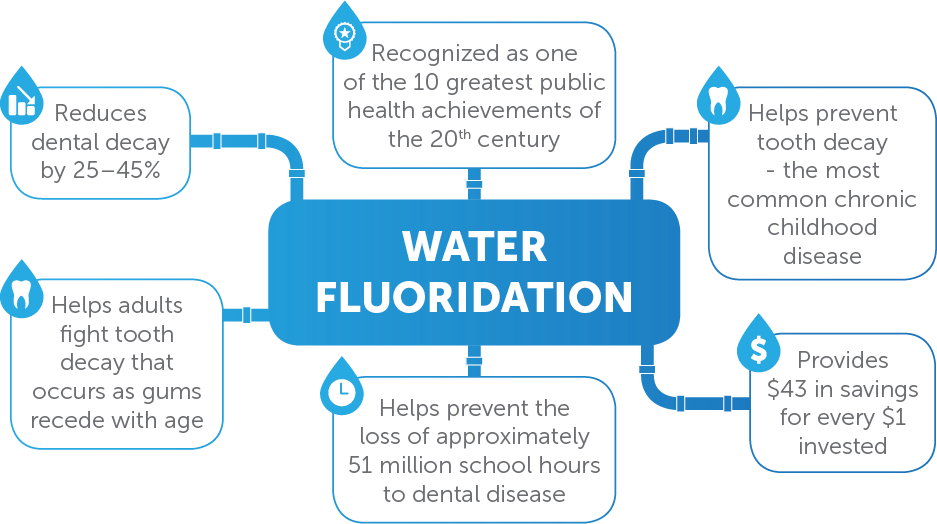What Is Fluoridation
Fluoride, a mineral found naturally in water, soil, and air (among other things), is needed to maintain healthy bones and teeth.
It strengthens the outside layer of your teeth, called the enamel, and helps prevent cavities.
Fluoride is added to many over-the-counter dental products, such as toothpaste and mouthwash, and it can also be taken as a supplement.
Prescription mouthwash containing higher amounts of fluoride is an option if you tend to get many cavities.
Even though it’s found naturally in water, natural fluoride levels are too low to prevent cavities, as to the Centers for Disease Control and Prevention (CDC).
That’s why many communities add small amounts of fluoride to their water systems in a process called water fluoridation.
Water fluoridation is the most cost-effective and feasible way to provide fluoride to everyone in a community.
Fluoridation of water was named one of the ten outstanding public health achievements of the 20th century by the CDC.
However, concerns have been raised over the safety of added fluoride in our drinking water. So, do we need to fluoridate our drinking water, and what does scientific research say about its safety?
WHY DO OUR TEETH NEED FLUORIDE and What Is Fluoridation
Your teeth are constantly losing minerals, so they must be replaced with minerals from our food, drinks, and dental products.
Fluoride strengthens your teeth by replenishing some of the minerals in your tooth enamel.
By constantly remineralizing the enamel, you can slow down the loss of minerals from your teeth, preserve your teeth’ strength for longer, and even reverse early signs of tooth decay.
Fluoride also fights off the growth of harmful bacteria in your mouth. Bacteria break down the carbohydrates and sugars you eat into acids, contributing to the loss of minerals from your teeth.
Your enamel acts as your teeth’ protective coating, so weakened enamel is more susceptible to being damaged by bacteria, creating cavities.
WHAT ARE THE BENEFITS OF FLUORIDATED WATER?
Water fluoridation first occurred in Grand Rapids, Michigan, in 1945. By the early 1950s, the benefits were already apparent — school children in Grand Rapids had fewer cavities than school children in nearby areas that did not fluoridate their water.
(You can find more details regarding the history of water fluoridation here: https://www.cdc.gov/mmwr/preview/mmwrhtml/mm4841a1.htm)
Since then, the vast majority of communities in the United States have fluoridated their water, and the public health effects of that are readily seen: the average number of missing or decaying teeth in 12-year-olds in the U.S. dropped by 68% between the late 1960s and early 1990s, according to the CDC.
This improvement in tooth health is not only due to fluoridating drinking water; it can be partially attributed to the increased use of fluoride-containing toothpaste and other dental products.
However, fluoridated water is directly responsible for reducing tooth decay in adults and children by 25%, according to the CDC.
School children who live in communities with fluoridated water have an average of two fewer decayed teeth than those who live in a community without fluoridated drinking water.
HOW SAFE IS FLUORIDATED WATER?
The safety of water fluoridation has been studied extensively for the 75 years that it has been implemented; according to the CDC, no unwanted health effects have been linked to water fluoridation in the U.S.
The American Dental Association (ADA), American Academy of Pediatric Dentistry (AAPD), and International Association for Dental Research (IADR) all endorse and recommend water fluoridation.
Water fluoridation also saves people and the health care system money by preventing cavities and tooth decay that would require visits to the dentist’s office to fix.
The only known side effect from ingesting too much fluoride is dental fluorosis, where minor white spots form on your tooth enamel due to too much fluoride exposure while the teeth are still developing under the gums.
There are no symptoms, and the condition is not harmful. It tends to affect children younger than eight years old primarily because they still have permanent teeth coming in.
Dental fluorosis can be mediated by making sure children aren’t swallowing toothpaste, which contains much more fluoride than water (toothpaste is the likely culprit of dental fluorosis, not fluoridated water).
THE CURRENT CONTROVERSY ON FLUORIDATED WATER SAFETY
Despite the vast amounts of evidence that fluoridated water is safe, some still claim fluoridated water causes a wide range of health problems, from lowering I.Q. to bone cancer.
However, the studies behind those claims give mixed results, with some research linking fluoridated water exposure to certain conditions and other studies finding no such link.
Most research linking fluoride to adverse health outcomes was done on people or populations that consume much higher amounts of fluoride than in U.S. drinking water.
Some also ask if fluoridating water is even necessary. The rates of 12-year-old children with cavities have decreased not only in countries that fluoridate their water but also in countries that don’t fluoridate their water.
Decreasing cavity rates in those countries are attributed to the use of fluoride-containing toothpaste and mouthwash.
According to the CDC, not every U.S. city fluoridates its water — as of 2014, about 75% of the U.S. has fluoridated water.
Each municipality decides to fluoridate community water. The CDC has a website where you can check if your city’s water is fluoridated: https://nccd.cdc.gov/DOH_MWF/Default/Default.aspx.
Suppose your city doesn’t fluoridate their water, and you want to make sure you’re getting enough fluoride.
In that case, you can use fluoride-containing toothpaste twice a day or mouthwash once a day (only recommended for children over six years).
Dentists also offer professional fluoride treatments to apply a gel, foam, or rinse with high amounts of fluorine to your teeth.
If you are concerned that your fluoride intake is too high, you can use fluoride-free toothpaste, a fluoride water filter, or drink bottled water rather than tap water.
Resources
Websites
“Achievements in Public Health, 1900–1999: Fluoridation of Drinking Water to Prevent Dental Caries.” Centers for Disease Control and Prevention Morbidity and Mortality Weekly Report, October 22, 1999. https://www.cdc.gov/mmwr/preview/mmwrhtml/mm4841a1.htm (accessed June 1, 2020).
“ADA Statement on Study in JAMA Pediatrics.” American Dental Association. August 19, 2019. https://www.ada.org/en/press-room/news-releases/2019-archives/august/ada-statement-on-study-in-jama-pediatrics (accessed June 1, 2020).
Cafasso, Jacquelyn. “What Is Fluoride, and Is It Safe?” Healthline. June 25, 2018. https://www.healthline.com/health/what-is-fluoride (accessed June 1, 2020).
Chuck, Elizabeth. “Science says fluoride in water is good for kids. So why are these towns banning it?” NBC News. October 17, 2018. https://www.nbcnews.com/news/us-news/science-says-fluoride-water-good-kids-so-why-are-these-n920851 (accessed June 1, 2020).
“Community Water Fluoridation.” Centers for Disease Control and Prevention (CDC). January 15, 2020. https://www.cdc.gov/fluoridation/index.html (accessed June 1, 2020).
“Community Water Fluoridation.” National Maternal and Child Oral Health Resource Center (OHRC). https://www.mchoralhealth.org/highlights/water-fluoridation.php (accessed June 1, 2020).
Davis, Nicole. “Is Fluoridated Drinking Water Safe?” Harvard Public Health Magazine. Spring 2016. https://www.hsph.harvard.edu/magazine/magazine_article/fluoridated-drinking-water (accessed June 1, 2020).
“Fluoride in Water.” American Dental Association (ADA). https://www.ada.org/en/public-programs/advocating-for-the-public/fluoride-and-fluoridation (accessed June 1, 2020).
“Policy on Use of Fluoride.” American Academy of Pediatric Dentistry (AAPD). 2018. https://www.aapd.org/research/oral-health-policies–recommendations/use-of-fluoride (accessed June 1, 2020).
Organizations
American Academy of Pediatric Dentistry (AAPD), 211 E Chicago Ave, Suite 1600, Chicago, IL, 60611, 312-337-2169, https://www.aapd.org.
American Dental Association (ADA), 211 E Chicago Ave, Chicago, IL, 60611, 312-440-2500, https://www.ada.org/en.
International Association of Dental Research (IADR), 1619 Duke St, Alexandria, VA, 22314-3406, 703-548-0066, Fax: 703-548-1883, https://www.iadr.org.
National Maternal and Child Oral Health Resource Center (OHRC), Georgetown University, Box 571272, Washington, DC, 20057-1272, 202-784-9771, OHRCinfo@georgetown.edu, https://www.mchoralhealth.org








